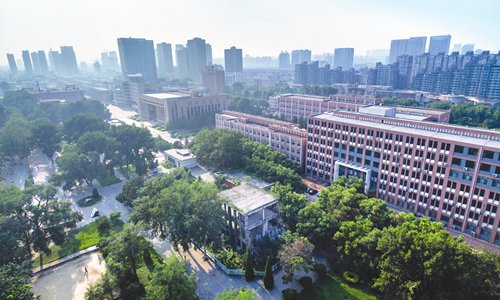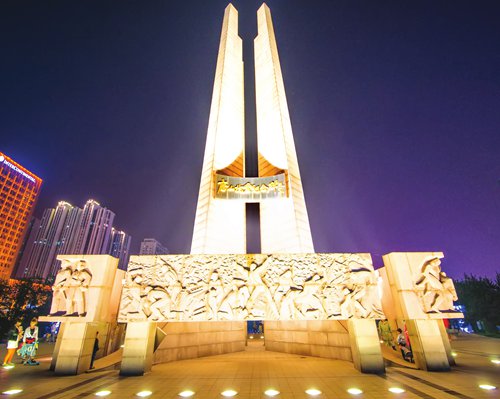HOME >> ARTS
Tangshan, Hebei Province: A symbol of tragedy and hope
By Tao Mingyang Source:Global Times Published: 2019/6/20 21:03:40

The campus of North China University of Science and Technology in Tangshan, North China's Hebei Province on July 26, 2016 Photo: IC

The Tangshan Earthquake Monument Photo: IC
Tangshan, located in the eastern part of Hebei Province, holds an important position in Chinese history. The city is famous for its coal mines and coal industry. However, a terrible earthquake in 1976 left a scar on people's hearts that may never truly heal. Over several decades of recovery, Tangshan has become a beautiful and harmonious place full of happiness.Underground history
In 1877, Qing Dynasty (1644-1911) general and diplomat Li Hongzhang appointed businessman Tong King-sing to oversee the establishment of the Chinese Engineering and Mining Company at the Kailuan coal mine, often called "the first fine coal mine in China."
To showcase the Kailuan coal mine's importance, the Kailuan Museum was opened to the public in October 2018.
The exterior of the museum was designed to look like the company's headquarters in Tianjin. The simple lines and decorations around the outside of the building reflect the museum's industrial theme.
Walking into the welcome hall of the museum, a 5-meter-tall, 15-meter-long relief that took 20 tons of brass to make grabs visitors' attention. The 79 figures on the relief represent the history of the Kailuan coal mine over its 100-year history.
The 3,000-square-meter exhibition area is divided into five parts including the natural formation of the coal mine, the development of the Chinese coal industry during the Self-Strengthening Movement(1861-95) and the later development of Tangshan's local coal industry.
The most exciting part of the museum is that visitors can take an elevator to visit the tunnels in the coal mine. After putting on a safety helmet, you can explore and learn about the miners' tough work place.
Mules were the main labor force in the coal mine. In olden days, the daily salary earned by workers was less than the amount of money needed to keep the mules fed.
Another important animal was also carried down to the coal mine. A type of small bird that was very sensitive to toxic gas. According to the tour guide, if the bird began tweeting loudly, workers knew it was time to evacuate the mine immediately.
As the industry developed, manpower and mules were retired and replaced with safer and more advanced technology.
Wooden supports were replaced by hydraulic pressure supports and dangerous explosive mining techniques were also replaced by advanced mining machinery.
Nowadays, the Kailuan coal mine is highly mechanized and ranks among the top mines around the world. Coal is supplied to Shanghai, Nanjing and Tianjin and also exported to other countries.
Not forgotten
On July 28, 1976, a destructive earthquake reaching 7.8 on the Ritcher scale rocked Tangshan.
More than 240,000 people lost their lives in the earthquake that nearly leveled the city.
To commemorate the victims, the municipal government built the Tangshan Earthquake Monument in the city center in 1986.
Standing in the center of a large square, the earthquake monument is made up of four concrete pillars. At the bottom of the monument, eight granite reliefs depict the people in Tangshan carrying out relief efforts and rebuilding their homes with helps from people all over the country.
The bottom level of the monument is made up of four platforms. These platforms are connected by 28 sets of stairs, each with seven steps - representing the date July 28.
Near the square is the Tangshan Earthquake Memorial, a large park that includes a museum.
The ruins of several destroyed buildings can be seen in the outer yard of the Tangshan Earthquake Memorial, allowing visitors to see for themselves first-hand the devastating power of the earthquake.
The key part of the memorial yard is a 7.28-meter-tall, 500-meter-long memorial wall upon which as inscribed all the names of the victims.
The memorial museum opened in July 1986. The museum gives some basic information about the earthquake and following efforts people made to overcome the disaster through real items, photos and documents.
From the ashes
Walking down the street of Tangshan, I had a hard time believing that the city had been hit with such destruction. After 43 years of recovery, Tangshan has become a beautiful, modern and international city.
To commemorate its rise from the ashes, the people of Tangshan like to refer to their home as the "city of the phoenix" after the legendary bird and many local restaurants and stores incorporate "phoenix" in their name as well.
"The earthquake caused everyone to come together so we could get through all these difficulties," I heard one elderly gentleman say at the monument square.
"This is why our city was able to be restored and become as beautiful as it is now."
Newspaper headline: City of the Phoenix
Posted in: CULTURE & LEISURE